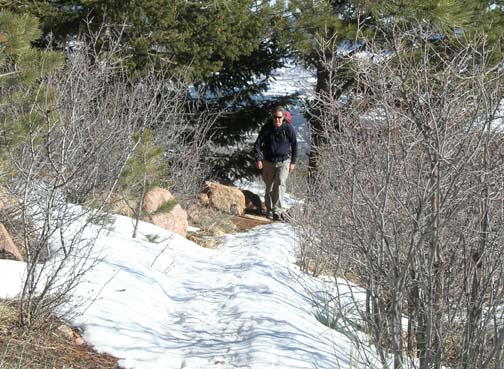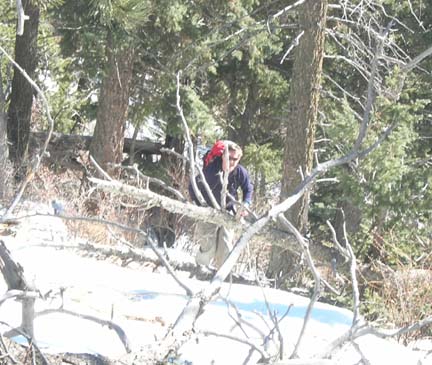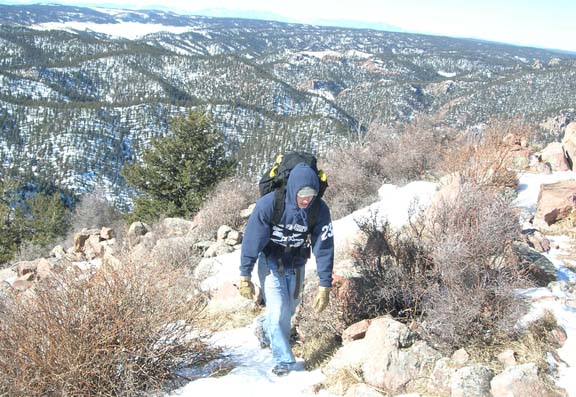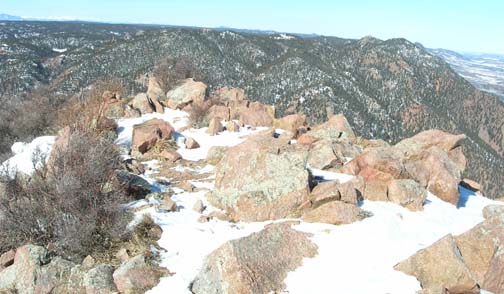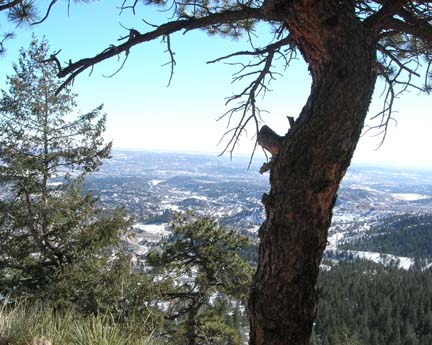Tom had suggested three options for a conditioning effort this weekend as we claw our way back into shape for winter climbing. In no particular order, he suggested 1) snow shoeing around flat Florissant National Monument 2) a 5 mile hike with loaded packs on the relatively flat Santa Fe Trail, or 3) hiking to Blodgett Peak, a moderate climb near the city.
I voted for #3 as Tom said he had a friend that climbs it all of the time for conditioning and with it so close, how hard can it be? Well in the summer, while it must be a very hot climb, it is probably just that, a conditioning climb, in shorts and carrying water. Yesterday in winter conditions it was a bit more… well, a lot more.
We left the trailhead with loaded winter packs (for conditioning) and quickly climbed the gently graded road to the water tower in the Blodgett Open Space. Having never hiked in this area before, we probably missed a side trail that left the road on the left so when we got to the water tower, we were faced with a badly eroded steep hill rising straight up. Bad erosion unfortunately in the name of the game on Blodgett as a “man made” trail does not exist and it is more of a climbers trail in the majority of the steep sections, leading to tough scree slopes that make upward progress dubious.
We met a young man named Mitchell at the water tower and he joined us for the remainder of the day. He was carrying a 65lb pack with climbing gear for conditioning as well while climbing in trail running shoes. As we started up the steep slope the morning sun was brutal even though it was in the low 20’s. The mud had melted and as I brought up the rear I actually saw “rivers of mud” flowing downhill at me. I felt like I was in California. While we knew there must be a better trail, none of us knew its location so we attempted to get up the slope as best as possible, without causing more damage.
After working our way up through this snowy, icy and muddy mess (yes all three together), we finally found a semblance of a trail and continued upward to what we thought was the base of the peak. The higher we got, the warmer it got, and slowly but surely we all stripped from fleece to exp. weight underwear to simply just our poly propylene layer. I applied sun screen to my face and neck on one stop as I could tell we were being baked.
Finally we reached a traversing trail to the west and hiked under the soaring rock face of a sub peak of Blodgett. Not knowing exactly where we were going the trail angled to a forested gully with deep snow and at first we were confused about the route until we found a climber’s trail heading up. A climbers trail is an ill-defined, “straight up” trail that is formed over time by people taking the path of least resistance… straight up! This part was icy and slippery; going up was tough, coming down would be dangerous. How Mitchell made it in his tennis shoes is unknown. This trail led to nasty scree slope quickly followed by another scree slope. Combined with the ice, it made for exhausting effort to again elevation.
We took a break in deep snow at the top of the 2nd scree slope and actually I was about to vote for calling it a day due to the conditions, but Tom rallied us and said onward to the summit! It was obvious now that we had one more headwall to get around and we actually still did not know where the peak was or it’s summit. I headed up the mainly straight up trail, now using the “rest step”. Tom later computed on his GPS that this section was 1000’+ vertical gain.
As Mitchell and I reached a saddle, the wind coming over quickly cooled us while we waited for Tom to join us. We decided that the actually summit was to our right and we waded through knee deep snow to work our way to the top. As we were reaching the top as the wind increased and the temperature dropped.
The summit is bare rock about 20′ by 40′ and the views of Colorado Springs and the Front Range are expansive. We could not dally on top due to the wind chill, so soon we opted to begin the hazardous journey down.
If going up was tough on the lungs and legs, going down was tougher on the knees and brains as you had to concentrate on every step on the icy steep slope. Crampons would have been perfect here. We got out of the wind and got Mitchell some tree limbs to use as poles and started our descent. A couple of times Mitchell did a 30′ glissade on his rear; once even on purpose 🙂 As we worked our way down the two nasty scree slopes, we finally obtained the traversing trail we had started on. Tom had mentioned that the guides to this peak mentioned that on the descent, many people get lost and miss the sub trails back to the water tower and the road. Chalk us on that list as well.
Tom slipped on some piece of icy trail and cut his hand on a rock…with blood dripping off his palm; I poured some iodine (I told him it would not sting, but I did not really know) and wrapped some gauze around his hand as we took a short break.
*Note: My sister, Sue, thought the above quote was funny about me not knowing whether it would hurt or not. I guess a full confession is required now. Tom: that iodine bottle was 12 years old from when we climbed together in 1993-1995. See a doctor soonest….
A short time later, we realized we had gone too far north and decided to bushwhack farther south down off a ridge. We encountered deep snow that I broke through it until we ran into a chain link fence. It was then very obvious to us we had misjudged and were on the Air Force Academy that bordered the peak. Somehow we all got over the fence, through the deep snow and climbed another ridge where we saw a house at the edge of the forest. We bushwhacked to that residential neighborhood and walked down city streets to regain the trailhead, after surmounting one additional ridge and bushwhack.
Needless to say, when we reached the Xterra, we were knackered… pulling off our muddy boots and piling in for the short drive home. Who would have thought a peak so close to the city in these conditions would prove so tough. After a day like yesterday it is clear to me that the right choice would have been option #2!
Beta:
5:13 elapsed time, 4.64 miles RT, 2500′ vertical, with > 1400 of it in the last mile.

